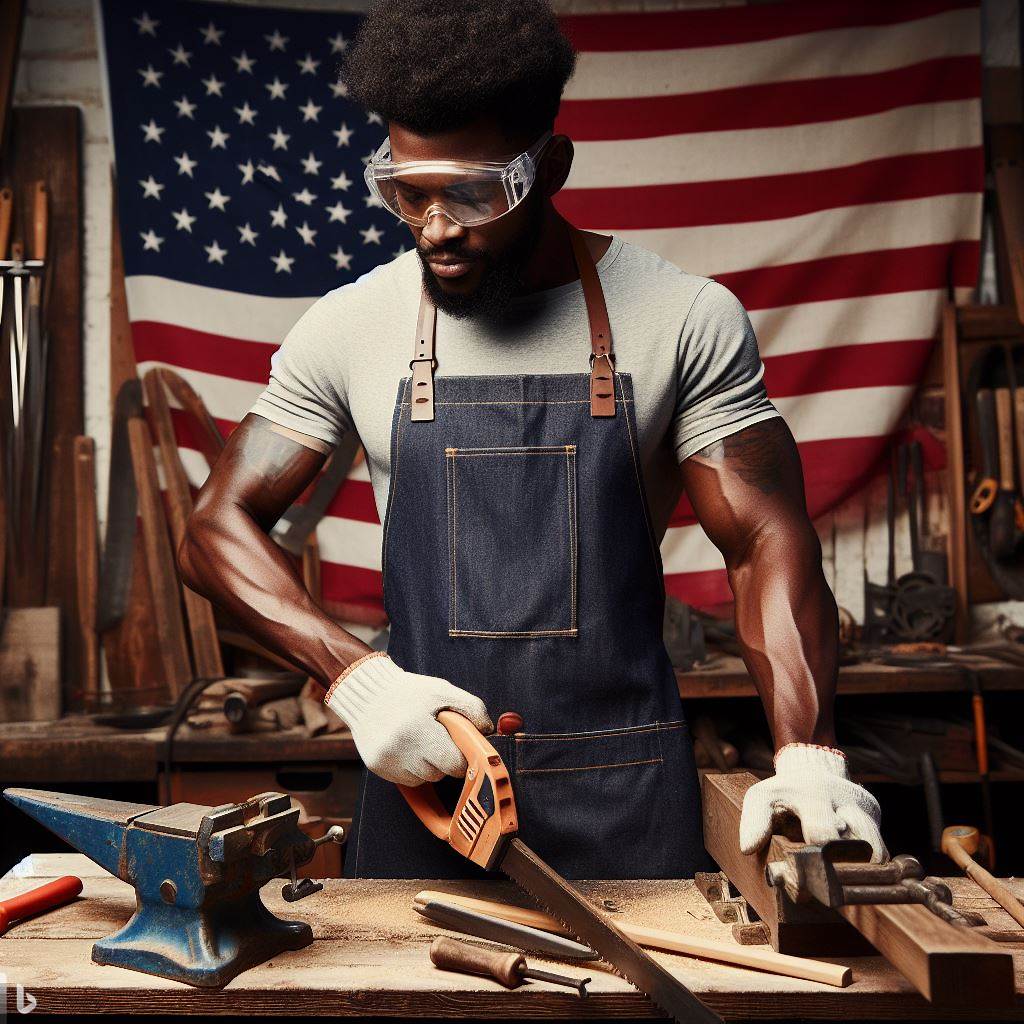Introduction
Woodworking holds great importance in American culture as it represents tradition, craftsmanship, and creativity.
Custom woodwork is a significant aspect of carpentry, allowing artisans to showcase their skills and create unique pieces.
This blog post will provide an overview of the content, highlighting the art and craft behind American carpentry and custom woodwork.
Woodworking’s Rich Heritage:
- Woodworking is deeply ingrained in American culture, reflecting our nation’s pioneer spirit and craftsmanship tradition.
- It played a pivotal role in the development of early American settlements, helping build homes, furniture, and tools.
- American carpenters have created iconic structures like the Liberty Bell and Independence Hall.
Custom Woodwork Unveiled:
- Custom woodwork is the heart and soul of carpentry, a manifestation of individuality in craftsmanship.
- It goes beyond functional utility, evolving into an art form that transcends mass-produced items.
- Custom woodwork allows artisans to create one-of-a-kind pieces tailored to personal preferences and needs.
What to Expect in this Blog Post:
- In this blog series, we will delve into the world of American carpentry and the magic of custom woodwork.
- We’ll explore the techniques, tools, and materials used by skilled woodworkers to create masterpieces.
- Discover the stories of talented artisans who breathe life into wood, turning it into functional and decorative marvels.
- You’ll gain insights into choosing the right wood for your projects and find inspiration for your own custom woodwork endeavors.
- Prepare to be captivated by the charm of American carpentry, where tradition meets innovation, and wood transforms into art.
Historical Background
Origins of Carpentry in America
- Carpentry in America has a long and rich history that dates back to the early colonial days.
- The Native Americans had their own woodworking traditions and techniques before the arrival of European settlers.
- With the establishment of the first colonies, carpentry became a crucial skill for survival.
- Early American carpenters built houses, furniture, and tools using locally available wood species.
- Blacksmiths and shipbuilders were also important figures in the development of carpentry in colonial America.
Influence of European Woodworking Traditions on American Carpentry
- European woodworking traditions, particularly those from England, had a significant impact on American carpentry.
- English carpenters brought their knowledge and skills to America, shaping the early development of the craft.
- The Gothic and Renaissance periods in Europe influenced architectural styles and carpentry techniques in America.
- German and Dutch settlers also played a role in shaping American carpentry with their unique woodworking practices.
- European influence can be seen in the use of joinery techniques, ornamental details, and furniture styles in American carpentry.
Key Historical Figures and Contributions to the Craft
- John Shaw, an English carpenter, is considered one of the first master builders in America.
- Thomas Jefferson, the third President of the United States, was a skilled architect and carpenter.
- Samuel McIntire, a famous American architect and woodcarver, contributed to the development of Federal-style architecture.
- George Nakashima, a Japanese-American woodworker, blended Eastern and Western woodworking traditions in his furniture designs.
- Today, there are countless talented carpenters and woodworkers who continue to shape the craft in America.
In summary, the origins of carpentry in America can be traced back to the early colonial days.
The influence of European woodworking traditions, particularly those from England, played a significant role in shaping American carpentry.
Key historical figures such as John Shaw, Thomas Jefferson, Samuel McIntire, and George Nakashima have made notable contributions to the craft.
Today, carpentry remains an important art form and craft, with talented individuals continuing to push the boundaries of custom woodwork in America.
Read: Safety Protocols: Best Practices in American Carpentry
Types of Custom Woodwork
Woodworking is a timeless craft that has been practiced for centuries.
American carpentry, in particular, is known for its artistry and craftsmanship in creating custom woodwork.
From intricate furniture pieces to intricate architectural details, custom woodwork adds beauty, functionality, and a touch of individuality to any space.
Furniture making
When it comes to custom furniture, there is a wide range of styles and designs available.
From traditional and classic pieces to modern and contemporary ones, custom furniture can be tailored to meet the specific needs and preferences of the customer.
Each style of furniture has its own unique characteristics, such as the use of curved lines, ornate carvings, or sleek, minimalist designs.
Another crucial aspect of custom furniture making is the choice of wood.
Different types of wood have distinct characteristics that contribute to the overall look and feel of the furniture.
Oak, for example, is known for its strength and durability, making it an excellent choice for furniture that needs to withstand daily wear and tear.
Transform Your Career Today
Unlock a personalized career strategy that drives real results. Get tailored advice and a roadmap designed just for you.
Start NowMahogany, on the other hand, boasts a rich, reddish-brown color and is often used in creating luxurious and elegant pieces.
Cabinetry
Custom cabinetry plays a vital role in home design. Whether it’s in the kitchen, bathroom, or any other room, cabinets provide functional storage solutions while adding beauty and elegance to the space.
Custom cabinetry allows homeowners to have cabinets that perfectly fit their specific needs and complement the overall design of the room.
There are various types of cabinets, each serving a different purpose. In the kitchen, custom kitchen cabinets can be designed to maximize storage space and improve functionality.
Bathroom cabinets, on the other hand, may focus more on aesthetics and creating a spa-like atmosphere.
Storage cabinets can be customized to fit specific areas, such as built-in bookshelves or entertainment centers.
Architectural Elements
Custom woodwork also plays a significant role in enhancing the architectural details of a space.
Moldings and trim, for example, add visual interest and sophistication to walls, ceilings, and doorways.
Custom-made moldings can feature intricate designs and patterns, creating a unique focal point in a room.
Architectural elements like crown moldings, chair rails, and baseboards can be tailored to match the overall style of a space, whether it’s classic, contemporary, or somewhere in between.
They provide a finishing touch that brings a sense of completion to the overall design.
In addition to moldings, custom woodwork can also include other architectural elements like columns, mantels, and staircases.
These elements add a sense of grandeur and elegance to any space, further enhancing its overall aesthetic appeal.
In fact, custom woodwork is a true art form that adds beauty, functionality, and individuality to any space.
Whether it’s through custom furniture, cabinetry, or architectural elements, the craftsmanship and attention to detail in American carpentry are evident.
The unique styles, designs, and use of various types of wood all contribute to creating custom woodwork that is truly exceptional.
Read: A Day in the Life of an American Carpenter: Real Stories
Uncover the Details: Top Welding Equipment Brands and Tools Preferred in the US
See Related Content: How to Choose the Right Fence for Your Property
Tools and Techniques
Common Woodworking Tools
- Saw: used for cutting wood into desired shapes and sizes.
- Router: used to hollow out an area in wood or create decorative edges.
- Chisel: used for carving, shaping, or removing small portions of wood.
- Drill: used to create holes in wood for screws or other fasteners.
- Clamps: used to hold pieces of wood together securely during assembly.
- Sander: used to smooth surfaces and remove imperfections in the wood.
Traditional and Modern Techniques
- Hand tools: Traditional techniques often involve the use of hand tools for more precise work.
- Power tools: Modern techniques rely heavily on power tools for efficiency and speed.
- Joinery: Traditional techniques emphasize precise joinery methods, such as dovetail and mortise-and-tenon joints.
- Finishing: Both traditional and modern techniques include applying finishes, such as varnish or lacquer, to protect and enhance the wood’s appearance.
- CNC technology: Modern techniques utilize computer numerical control (CNC) machines for more complex designs and accurate cuts.
Importance of Craftsmanship and Attention to Detail
Craftsmanship in custom woodwork is crucial as it distinguishes a piece of work as exceptional.
Transform Your Career Today
Unlock a personalized career strategy that drives real results. Get tailored advice and a roadmap designed just for you.
Start NowAttention to detail ensures a high-quality, finished product that meets the client’s expectations.
It showcases the skill and dedication of carpenters, resulting in customer satisfaction and reputation building.
When carpenters incorporate their craftsmanship into custom woodwork, it adds value and uniqueness to the final product.
Each item becomes a work of art, exhibiting the skill and creativity of the carpenter. Clients appreciate the time and effort put into the piece, making it more desirable and often commanding a higher price.
Attention to detail is vital in custom woodwork as it ensures precision and perfection in every aspect of the project.
Whether it’s the flawless joints, smooth surfaces, or intricate designs, a keen eye for detail enhances the overall aesthetic appeal of the work.
It also guarantees functionality and longevity of the piece, as it is meticulously crafted to withstand everyday use.
Moreover, craftsmanship and attention to detail reflect the values and pride of the carpenter.
It demonstrates their commitment to delivering exceptional workmanship to their clients.
Carpenters who prioritize craftsmanship and attention to detail establish a reputation for excellence, attracting more customers and fostering long-term relationships.
In short, a wide range of tools, both traditional and modern, are used in custom woodwork to achieve desired results.
Craftsmanship and attention to detail are fundamental for creating outstanding custom woodwork that stands out from mass-produced alternatives.
Carpenters who master these skills enhance their reputation and leave a lasting impression on their clients.
Read: Union vs. Non-Union Carpentry: Pros, Cons & Differences

Challenges and Rewards of Custom Woodwork
Challenges faced by carpenters in creating custom woodwork
- Meeting the clients’ specific requirements while balancing functionality and aesthetics.
- Working with a variety of wood species, each with its own characteristics and challenges.
- Maintaining accurate measurements and precision throughout the entire woodwork process.
- Dealing with complex joinery techniques and intricate designs that require advanced skills.
- Managing time constraints and meeting deadlines amidst the intricate nature of custom projects.
- Ensuring the pieces’ stability and durability, especially for large-scale custom woodwork.
- Negotiating with clients on pricing and managing their expectations throughout the project.
- Working in unconventional spaces or challenging environments that may lack proper tools or equipment.
- Handling unforeseen obstacles or changes in the project scope that require quick problem-solving.
- Adapting to new technologies and trends while preserving traditional woodworking techniques.
Overcoming challenges leads to personal and professional growth
By facing and conquering challenges, carpenters in the realm of custom woodwork experience remarkable growth in several areas of their lives:
- Technical Skills: Every challenge encountered becomes an opportunity to acquire new techniques and improve craftsmanship.
- Problem-Solving Abilities: Overcoming obstacles hones the carpenter’s ability to find innovative solutions.
- Adaptability: Dealing with different wood species and project demands enhances flexibility and adaptability.
- Project Management: Handling time constraints and client expectations fosters efficient project management skills.
- Communication: Negotiating with clients develops effective communication and client relationship-building skills.
- Creativity: Working on intricate designs encourages out-of-the-box thinking and creativity.
- Resilience: Overcoming challenges fosters resilience and mental strength to tackle future projects.
- Confidence: Successfully completing complex woodwork boosts self-assurance and professional confidence.
- Continuous Learning: Adapting to new technologies and trends ensures professional growth and staying relevant.
- Professional Reputation: Consistently overcoming challenges enhances a carpenter’s reputation in the industry.
Satisfaction and pride in creating unique and high-quality woodwork pieces
The challenges in custom woodwork are undoubtedly worth the rewards they bring, including the following:
- Satisfaction: Creating tailor-made pieces that meet clients’ expectations brings immense satisfaction to carpenters.
- Pride in Craftsmanship: Handcrafting unique and high-quality woodwork showcases a carpenter’s pride in their skill and artistry.
- Client Appreciation: Happy clients appreciating and valuing the custom pieces reinforce the carpenter’s sense of achievement.
- Legacy and Durability: Custom woodwork pieces can be passed down through generations, leaving a lasting legacy.
- Artistic Expression: Custom projects allow carpenters to express their creativity and artistic vision.
- Recognition and Awards: Exceptional custom woodwork has the potential to earn prestigious recognition and awards.
- Sustainable and Eco-Friendly: Custom woodwork promotes sustainability by using ethically sourced materials and reducing waste.
- Unique Professional Identity: Creating custom woodwork sets a craftsman apart, establishing a distinct professional identity.
- Future Opportunities: Successful custom woodwork projects often lead to new and exciting opportunities.
In general, the challenges faced in custom woodwork not only test a carpenter’s skills and expertise but also contribute to their personal and professional growth.
The rewards, including satisfaction, pride, and unique creations, make this craft both challenging and immensely fulfilling.
Read: Financial Overview: Carpenter‘s Average Salary in the US
Discover More: The Impact of Housing Trends on Carpentry in the USA
Transform Your Career Today
Unlock a personalized career strategy that drives real results. Get tailored advice and a roadmap designed just for you.
Start NowConclusion
In this blog post, we explored the art and craftsmanship behind American carpentry.
Through custom woodwork, artisans create unique pieces that showcase their skill and creativity.
It is important for readers to recognize and appreciate the beauty and significance of custom woodwork.
By valuing and supporting this traditional craft, we can ensure its preservation for future generations.
Custom woodwork is not just about practicality but also about creating pieces that are works of art.
Whether it’s a handcrafted table or an intricately carved cabinet, every piece tells a story.
The dedication and skill of American carpenters deserve recognition and admiration.
So, let us take a moment to appreciate the talent and hard work that goes into creating custom woodwork.
Next time you see a hand-carved chair or a meticulously crafted staircase, pause and admire the artistry behind it.
Custom woodwork is a testament to human creativity and a celebration of our ability to shape and transform natural materials.
As we conclude this blog post, let us continue to support and promote the art of American carpentry.
[E-Books for Sale]
The Big Book of 500 High-Paying Jobs in America: Unlock Your Earning Potential
$19.99 • 500 High-Paying Jobs • 330 pages
Explore 500 high-paying jobs in America and learn how to boost your career, earn more, and achieve success!
See All 500 High-Paying Jobs of this E-Book
1001 Professions Without a Degree: High-Paying American Jobs You Can Start Now
$19.99 • 1001 Professions Without a Degree • 174 pages
Discover 1001 high-paying jobs without a degree! Unlock career tips, skills, and success strategies for just $19.99!




